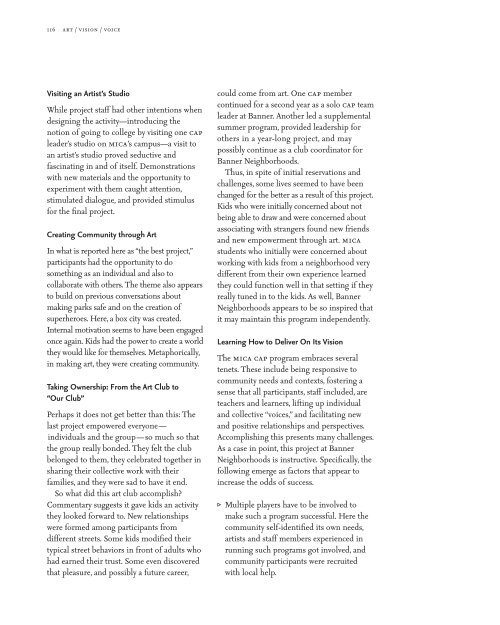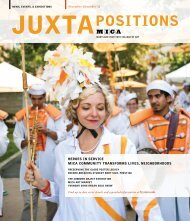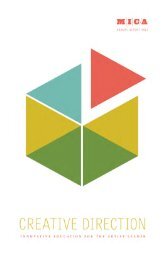art/vision/voice - Maryland Institute College of Art
art/vision/voice - Maryland Institute College of Art
art/vision/voice - Maryland Institute College of Art
You also want an ePaper? Increase the reach of your titles
YUMPU automatically turns print PDFs into web optimized ePapers that Google loves.
116 <strong>art</strong> / <strong>vision</strong> / <strong>voice</strong><br />
Visiting an <strong>Art</strong>ist’s Studio<br />
While project staff had other intentions when<br />
designing the activity—introducing the<br />
notion <strong>of</strong> going to college by visiting one cap<br />
leader’s studio on mica’s campus—a visit to<br />
an <strong>art</strong>ist’s studio proved seductive and<br />
fascinating in and <strong>of</strong> itself. Demonstrations<br />
with new materials and the opportunity to<br />
experiment with them caught attention,<br />
stimulated dialogue, and provided stimulus<br />
for the final project.<br />
Creating Community through <strong>Art</strong><br />
In what is reported here as “the best project,”<br />
p<strong>art</strong>icipants had the opportunity to do<br />
something as an individual and also to<br />
collaborate with others. The theme also appears<br />
to build on previous conversations about<br />
making parks safe and on the creation <strong>of</strong><br />
superheroes. Here, a box city was created.<br />
Internal motivation seems to have been engaged<br />
once again. Kids had the power to create a world<br />
they would like for themselves. Metaphorically,<br />
in making <strong>art</strong>, they were creating community.<br />
Taking Ownership: From the <strong>Art</strong> Club to<br />
“Our Club”<br />
Perhaps it does not get better than this: The<br />
last project empowered everyone—<br />
individuals and the group—so much so that<br />
the group really bonded. They felt the club<br />
belonged to them, they celebrated together in<br />
sharing their collective work with their<br />
families, and they were sad to have it end.<br />
So what did this <strong>art</strong> club accomplish?<br />
Commentary suggests it gave kids an activity<br />
they looked forward to. New relationships<br />
were formed among p<strong>art</strong>icipants from<br />
different streets. Some kids modified their<br />
typical street behaviors in front <strong>of</strong> adults who<br />
had earned their trust. Some even discovered<br />
that pleasure, and possibly a future career,<br />
could come from <strong>art</strong>. One cap member<br />
continued for a second year as a solo cap team<br />
leader at Banner. Another led a supplemental<br />
summer program, provided leadership for<br />
others in a year-long project, and may<br />
possibly continue as a club coordinator for<br />
Banner Neighborhoods.<br />
Thus, in spite <strong>of</strong> initial reservations and<br />
challenges, some lives seemed to have been<br />
changed for the better as a result <strong>of</strong> this project.<br />
Kids who were initially concerned about not<br />
being able to draw and were concerned about<br />
associating with strangers found new friends<br />
and new empowerment through <strong>art</strong>. mica<br />
students who initially were concerned about<br />
working with kids from a neighborhood very<br />
different from their own experience learned<br />
they could function well in that setting if they<br />
really tuned in to the kids. As well, Banner<br />
Neighborhoods appears to be so inspired that<br />
it may maintain this program independently.<br />
Learning How to Deliver On Its Vision<br />
The mica cap program embraces several<br />
tenets. These include being responsive to<br />
community needs and contexts, fostering a<br />
sense that all p<strong>art</strong>icipants, staff included, are<br />
teachers and learners, lifting up individual<br />
and collective “<strong>voice</strong>s,” and facilitating new<br />
and positive relationships and perspectives.<br />
Accomplishing this presents many challenges.<br />
As a case in point, this project at Banner<br />
Neighborhoods is instructive. Specifically, the<br />
following emerge as factors that appear to<br />
increase the odds <strong>of</strong> success.<br />
v Multiple players have to be involved to<br />
make such a program successful. Here the<br />
community self-identified its own needs,<br />
<strong>art</strong>ists and staff members experienced in<br />
running such programs got involved, and<br />
community p<strong>art</strong>icipants were recruited<br />
with local help.
















